UNDER CONSTRUCTION: Artifacts in Survey Grid
Ceramics
The earthenware ironstone shard and shard with the “Ironstone” inscription may be similar to an ironstone shard previously noted during the 2017 field season. During the 2017 field season, a ceramic shard with the maker’s mark of “Ironstone China” was noted on the bottom of an artifact (The ironstone shard) is a partial section of a small ironstone bowl. The fabric is off-white, with a thick white glaze and a decorative blue stripe just above the base. The fabric is very fine, with a few small inclusions. The bottom of the bowl does not have a manufacturer’s mark, and there are no other markings aside from the single blue stripe. Based on the nature of the fabric, the color and sheen of the glaze, and the weight of the object, it was determined that the bowl is ironstone rather than porcelain (Florida Museum of Natural History).
Ironstone is a type of refined earthenware, first invented in England and produced between 1840 and 1930 (Florida Museum of Natural History). It was invented by Charles Mason and was patented and sold as Mason Ironstone China. Later, the ware was produced by several manufacturers in the United States and by more potters in England. The moniker “ironstone” came from the fact that the ware is extremely durable, making it an excellent alternative to more fragile porcelain for utilitarian objects (The Potteries). It is normally white, but can be slightly bluish, and usually has a thick, glassy glaze. Pieces were decorated using the techniques of transfer printing, painting, or enameling. Common vessel forms include plates, bowls, basins, platters, and tureens, but other table service items such as teacups and various household vessels such as pitchers were also produced (Florida Museum of Natural History).
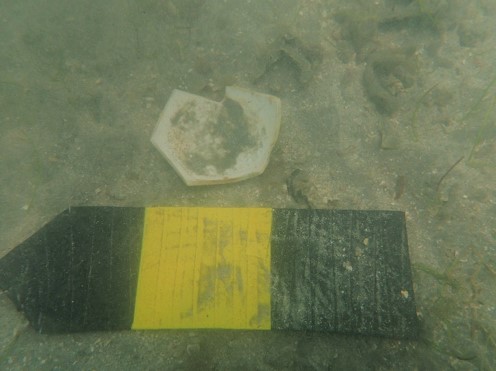
Ironstone ceramic base found in situ during the 2018 field project (Emily DiBiase and Joel Cook/ECU and CCB Embajadores, 2018).
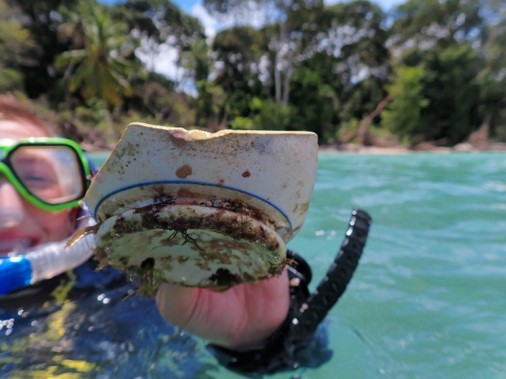
Ironstone ceramic base found during the 2018 field project (Emily DiBiase and Joel Cook/ECU and CCB Embajadores, 2018).
Case Gin bottles
The case gin bottle was a popular shape made in Europe in the early to mid- 17th century. More specifically, case gin bottles probably originated in either the Netherlands or England during that time (Ramey 2017). In fact, the term “case bottle” originally referred to an octagonal bottle, not the tapered, square-sided Dutch gin bottle that the phrase now calls to mind (Munsey 2009:3). However, the date above is the date attached to the first examples of the square-sided shape. These bottles were designed to facilitate transportation and storage in wooden cases. Their tapered sides and square shape allowed more bottles to fit in a container and allowed them to be removed easily (Munsey 2009:3). Such bottles contained a variety of spirits and substances, such as schnapps and bitters that were consumed sometimes as alcoholic beverages and sometimes as medicines. Case gin bottles and fragments found in the New World that pre-date the 19th century were probably European imports. Production of case gin bottles in the United States is not thought to have begun until the early 19th century (Ramey 2017).
Case gin bottles dating to the 17th century differ little from those of the 18th and 19th centuries. One distinguishing characteristic is that earlier bottles were tapered less steeply that later examples (Munsey 2009:3). Nationality of origin is often more difficult to pin down unless the bottle carries a company name or other type of marking. This is due to the fact that glass manufacturers in England and the United States frequently employed Dutch craftsmen, and Dutch manufacturers were known to employ English and American craftsmen (Munsey 2009:3). Such exchanges of expertise made the case gin bottle more uniform across manufacturers, rather than allowing distinct forms to develop in different areas of the world.
One fragment bears the letters “Cosmopo” with the head and torso of a man. The full inscription should be “Cosmopoliet”, with the image of a man holding a gin bottle. This type of bottle was made by J.J. Melchers WZ Distillery of Schiedam, Holland, and dates to the late 19th century (Munsey 2009:22). The other fragment has the inscription “AYEN”. This seems to be the last few letters of “J. T. GAYEN” and refers to Jan Tecker Gayen, who was a distiller of schnapps and other liquors in Alton, Hamburg, Germany. This type of bottle was produced during the late 19th century (Meyer 2013).
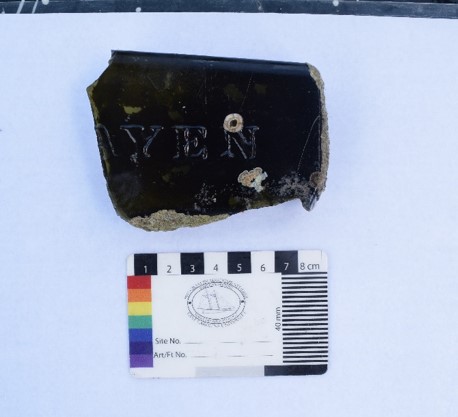
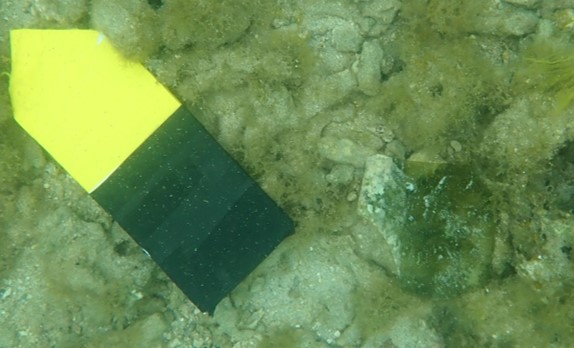
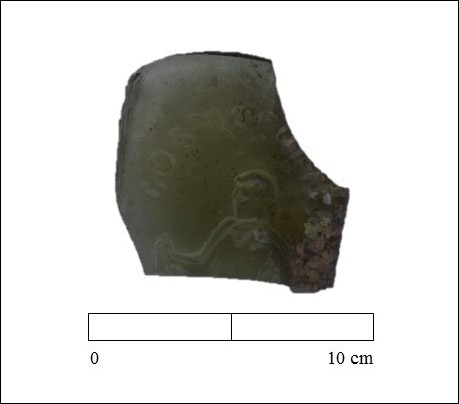
Fragment of decorated glass bottle labeled with “Cosmopo” (Credit: Lynn Harris, ECU)
Pipes
Two ceramic pipe pieces were found during the 2018 field survey. One pipe piece is a type of brown spur bowl. The spur appears short and rounded, a style that developed in the early 1600s (Oswald 1975). The existing stem is approximately 30cm long. There is no decoration or maker’s mark on the pipe.
In the mid-sixteenth century, tobacco use was popular amongst men and women. At the time, people used pipes that were made of clay bowls and clay stems (Alpern 1995:26-27). Some of the more ornate pipes were made of silver, and were considered symbols of wealth and rank (Alpern 1995:29). According to Jessica Glickman (2015:71-72) in her Master’s thesis A War at the Heart of Man: The Structure and Construction of Ships Bound for Africa, sailor’s collected and used personal belongings such as pipes while onboard vessels. Glickman argues that, “pipes and pipe stems are the most datable” artifacts since their design and use have been researched extensively in archaeology. It is possible that the pipes found during the 2018 field season may help provide a date range for site.

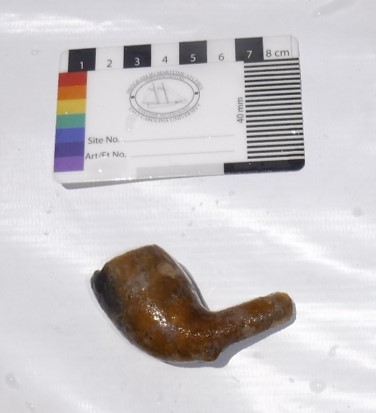
References
Alpern, Stanley B.
1995 What Africans Got for Their Slaves: A Master List of European Trade Goods. History in Africa 22(1):5-43.
Florida Museum of Natural History
2018 Ironstone, Undecorated – Type Index. Historical Archaeology at the Florida Museum of Natural History, University of Florida, Gainesville
<https://www.floridamuseum.ufl.edu/histarch/gallery_types/type_index_display.asp?type_name=IRONSTONE,%20UNDECORATED>. Accessed 21 November 2018.
Glickman, Jessica A.
2015 A War at the Heart of Man: The Structure and Construction of Ships Bound for Africa. Master’s Thesis, Department of History, University of Rhode Island, Kingston, RI.
Munsey, Cecil
2009 “Gin Bottles: A Historical and Pictorial Essay.” Originally published as Munsey, Cecil. The Illustrated Guide to COLLECTING BOTTLES. New York: Hawthorn Books, Inc. Publishers, 1970, pp. 84-86. Reformatted for web access. http://www.cecilmunsey.com/images/1238_GIN_BOTTLES.pdf
Oswald, A.
1975 Clay Pipes for the Archaeologist. British Archaeological Reports 14. Archaeopress, Oxford.
http://www.pipearchive.co.uk/howto/date.html
Ramey, Robin
2017 “Case Bottles”. C.A.R.T. Archaeology of Virginia, WordPress. https://cartarchaeology.wordpress.com/2017/10/27/case-bottles/
The Potteries
2018 The Origin of Ironstone. The Potteries. The Potteries, Steve Birks. <http://www.thepotteries.org/features/ironstone.htm>. Accessed 21 November 2018.